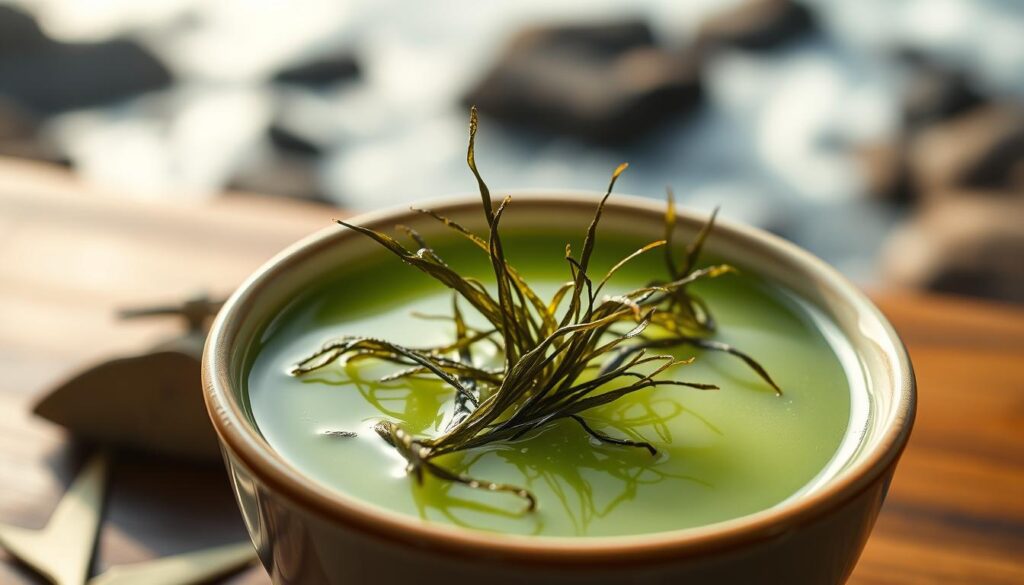For centuries, coastal communities have been enjoying desserts made from the sea’s bounty. Carrageen moss, a type of seaweed, has been a staple ingredient in traditional desserts, particularly in Ireland, Scotland, and England, where it’s been used for at least 4000 years.
We’re excited to share our journey into the world of seaweed pudding, a dessert with a rich history that spans generations. By combining traditional techniques with modern twists, we transform simple ingredients into a sophisticated culinary experience.
Our recipe for seaweed pudding balances delicate flavors and achieves a silky texture, making it a unique dessert that’s sure to impress. With a deep understanding of the science behind cooking, we’re committed to preserving traditional food knowledge while making it accessible to modern home cooks.
Key Takeaways
- Explore the traditional dessert of seaweed pudding and its roots in coastal communities.
- Learn how to transform simple sea ingredients into a sophisticated culinary experience.
- Discover our extensively tested recipe for achieving the perfect silky texture.
- Understand the science behind selecting quality carrageen moss and achieving the ideal set.
- Appreciate the connection between this dessert and coastal culinary traditions.
The History and Benefits of Seaweed Pudding
The history of seaweed pudding is a fascinating tale that spans thousands of years, deeply rooted in the coastal communities of Ireland and Scotland. For at least 4000 years, North Atlantic seaweeds have been utilized by coastal dwellers in these regions.
Origins in Irish and Scottish Coastal Communities
The earliest recorded account of seaweed pudding dates back to a poem attributed to Saint Columba, a native of Donegal, Ireland, in A.D. 563. Irish moss or carrageen moss has been a staple in the diets of people in Ireland, Scotland, and England, serving as a vital dietary supplement during times of need, such as the great potato famine.
The ingenious use of carrageen moss by coastal people demonstrates how communities historically utilized local resources to create nourishing foods during times of scarcity. The traditional moss pudding recipes were passed down through generations, with each family developing their own variations while maintaining the core techniques.

Nutritional Value and Health Benefits
Seaweed pudding is not only a dish with a rich history, but it also boasts an impressive nutritional profile. It contains minerals, iodine, and other trace elements that were historically difficult to obtain from other food sources. The way seaweed was harvested, dried, and prepared reflects generations of accumulated knowledge about sustainable food practices from the sea.
| Nutritional Element | Benefit |
|---|---|
| Minerals | Essential for various bodily functions |
| Iodine | Crucial for thyroid health |
| Trace Elements | Supports overall well-being |
We’ve researched how traditional communities recognized the health benefits of carrageen moss long before modern nutritional science confirmed its value. This traditional knowledge has been passed down through the people of these coastal communities, highlighting the importance of preserving culinary heritage.
Selecting and Preparing Irish Moss for Seaweed Pudding
Crafting seaweed pudding that’s both nutritious and delicious starts with understanding how to choose and prepare Irish moss. The quality of your carrageen moss significantly impacts the final product, making the initial steps crucial.
How to Source Quality Carrageen Moss
The best carrageen moss is harvested during the lowest spring tides in summer, particularly in July and August. We recommend sourcing your moss from clean, unpolluted waters, looking for the characteristic reddish-purple or greenish fronds that indicate healthy, vibrant moss. For those unable to harvest their own, guidance on selecting quality dried carrageen moss from reputable suppliers is essential.
Cleaning and Soaking Techniques
Our tested cleaning technique involves multiple rinses in cold water to remove sand, salt, and any small sea creatures. Soaking the moss in cold water with a squeeze of lemon or lime juice not only cleans it but also softens the distinctive sea flavor.
Drying and Storing Methods
The traditional drying method requires spreading the cleaned moss on a white sheet in direct sunlight for at least a week. Proper storage in a breathable container like a cotton bag in a cool, dark place preserves your dried carrageen moss for up to a year.
Our Traditional Seaweed Pudding Recipe
After refining our seaweed pudding recipe through rigorous testing, we’re excited to share our traditional method with you. This dessert, rooted in Irish and Scottish coastal traditions, requires precision and patience, but the result is well worth the effort.
Essential Ingredients and Equipment
To make our traditional seaweed pudding, you’ll need a few key ingredients and some specific equipment. The ingredients include 7g of dried carrageen moss, 900ml of full-fat milk, one vanilla pod (or pure vanilla extract), one large egg, and two tablespoons of superfine sugar. For equipment, we recommend a heavy-bottomed saucepan for even heat distribution, a fine-mesh sieve for straining, and glass serving dishes to showcase the pudding’s delicate appearance.
Step-by-Step Cooking Process
The process begins with soaking the carrageen moss in tepid water for 10 minutes to help it expand and release its gelling properties. Then, it’s added to the milk and vanilla pod in a saucepan, brought slowly to a boil, and simmered gently for about 15 minutes.
Simmering the Seaweed
Maintaining a very gentle heat is crucial when simmering the seaweed in milk. This ensures the carrageen moss softens properly without the milk boiling over.
Testing for the Perfect Set
To test for the perfect set, place a small amount of the mixture on a cold saucer. If it firms up as it cools, it’s ready. If not, adjust with a bit more milk as needed.
Incorporating Egg Whites for Texture
Separating the egg and whisking the white to a stiff peak before gently folding it into the mixture creates a delicate, fluffy layer on top of the pudding, enhancing its texture.
Chilling and Setting Tips
Patience is key when it comes to chilling the pudding. At least three hours in the refrigerator allows it to develop its characteristic soft set and silky texture. This step is crucial for achieving the desired consistency and flavor.
By following these steps and using quality ingredients, you’ll be able to create a delicious and authentic seaweed pudding that’s sure to impress.
Serving Suggestions and Flavor Variations
The beauty of seaweed pudding is in its neutrality, making it a perfect canvas for creative flavor combinations. We’ve discovered that one of the most appealing aspects of this dessert is its chameleon-like ability to take on whatever flavors you pair with it, making it an incredibly versatile dessert base.
Traditionally, carrageen moss pudding is served chilled, topped with a dollop of softly whipped cream and a sprinkle of dark brown sugar, which complements its delicate texture perfectly. We’ve also experimented with seasonal fruit compotes—such as summer berries, poached pears, or stewed apples—which add vibrant flavor and color to the otherwise pale pudding.
For special occasions, consider topping the pudding with Irish Coffee Sauce, a specialty of Ballymaloe House, creating a sophisticated dessert with complex flavors. The neutral taste of the basic carrageen pudding makes it an excellent canvas for various flavor infusions during cooking. Try adding cinnamon sticks, star anise, or cardamom pods to the milk for unique flavor profiles.
Different cultures have their own twists; for example, Caribbean variations use cinnamon, nutmeg, and lime to transform the pudding into both a dessert and a nutritious drink. You can also brighten the flavor profile by adding citrus zest to the milk mixture or use different sweeteners like honey or maple syrup to adjust the sweetness and contribute distinct flavor characteristics.


